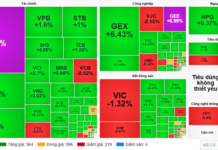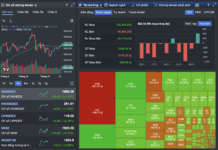Intensifying Workforce Reductions
According to the third-quarter financial reports, numerous banks have implemented significant workforce reductions. This wave of layoffs is not confined to a small group but has spread across the entire banking sector. Notably, LPBank has been the most aggressive in downsizing its workforce. As of September 30th, LPBank’s employee count stood at 9,416, reflecting a reduction of 1,773 employees over the past nine months. In contrast, during the same period last year, LPBank added 562 employees.

Mass layoffs in the banking sector.
VIB and Sacombank also experienced substantial workforce reductions, with both banks cutting over 1,000 employees in the first nine months of the year. Specifically, Sacombank reduced its workforce by 1,354 employees, leaving it with 16,734 staff members. VIB cut 1,096 employees, bringing its total down to 10,640.
Beyond these banks, several other major financial institutions have reported a decline in their employee numbers, with reductions typically ranging from a few hundred.
ABBank reduced its workforce by 589 employees, Vietcombank by 492, HDBank by 488, KienlongBank by 447, ACB by 268, SeABank by 226, TPBank by 221, and Eximbank by 203.
Some banks have reduced their workforce by fewer than 100 employees in the first nine months of 2025, including OCB with a reduction of 95, PGBank with 49, Saigonbank with 19, and MSB with 7.
Reasons Behind Workforce Reductions
In an interview with Tiền Phong, Mr. Nguyễn Quang Huy, an expert from the Faculty of Finance and Banking at Nguyễn Trãi University, emphasized that the workforce reductions in the banking sector are not indicative of a downturn but rather a preparation for a new growth cycle.
According to Mr. Huy, banks will adjust their workforce structures from now until the end of the year to enhance productivity, meet increasingly stringent risk management standards, and adapt to the accelerating digital banking model. The goal is not merely to reduce staff but to establish new standards that will make operational systems more efficient.
Alongside workforce optimization, banks continue to recruit, particularly in sales and digital sectors. Priority is given to young, adaptable employees who are tech-savvy and proficient in using artificial intelligence (AI), ChatGPT, and digital platforms to boost productivity and develop business strategies within the digital ecosystem. In reality, digitalization does not eliminate jobs but creates new, higher-value roles.
Digital tools such as robotic process automation software, electronic workflows, data analytics, digital identification, and automated digital business processes help streamline repetitive tasks, reduce errors, shorten processing times, and increase overall system productivity. This allows employees to focus on customer consultation, care, and business development, while also acquiring new skills and taking on strategic roles. Banks are not eliminating human roles—they are enhancing them.
Mr. Huy believes that the workforce optimization process aims to retain employees who are eager to learn, tech-savvy, data-driven, multi-skilled, and adaptable to the digital environment. Those who are unable or unwilling to adapt may face internal transfers, with reductions being a last resort, implemented sparingly and with clear intent.
In the long term, Vietnam’s banking sector has immense growth potential. With projections of high economic growth and Vietnam’s ambition to become an international financial hub, the demand for high-quality talent is expected to rise rapidly, particularly for individuals with practical expertise and the ability to operate financial and banking models to international standards.
“Vietnam’s banking sector is restructuring to become stronger, not smaller. Digitalization is creating new personnel needs, and banks are increasing recruitment in digital and sales roles. Automation is helping employees elevate their value. These are crucial steps to prepare the sector for a new phase of growth,” Mr. Huy stated.
At a recent press conference on third-quarter banking performance, Mr. Phạm Chí Quang, Director of the Monetary Policy Department at the State Bank of Vietnam, noted that since 2022, the banking sector has worked to reduce operational costs through various measures, including organizational restructuring, transaction process automation, and the expansion of online services. The current trend of workforce reductions is occurring alongside the sector’s restructuring and technological integration efforts.
Ho Chi Minh City Ready to Lead as a Testing Ground for Innovative Economic Strategies, Says Party Secretary Tran Luu Quang
Ho Chi Minh City stands ready to lead as a pioneering hub, fostering the incubation of innovative strategies, birthing groundbreaking ideas, and disseminating successful models across the nation and beyond.
SHB and Vietnam Chemical Group Sign Strategic Cooperation Agreement
The partnership between SHB and Vinachem marks a significant new chapter in the relationship between these two leading enterprises, while also driving sustainable, modern, and integrated socio-economic development.










































